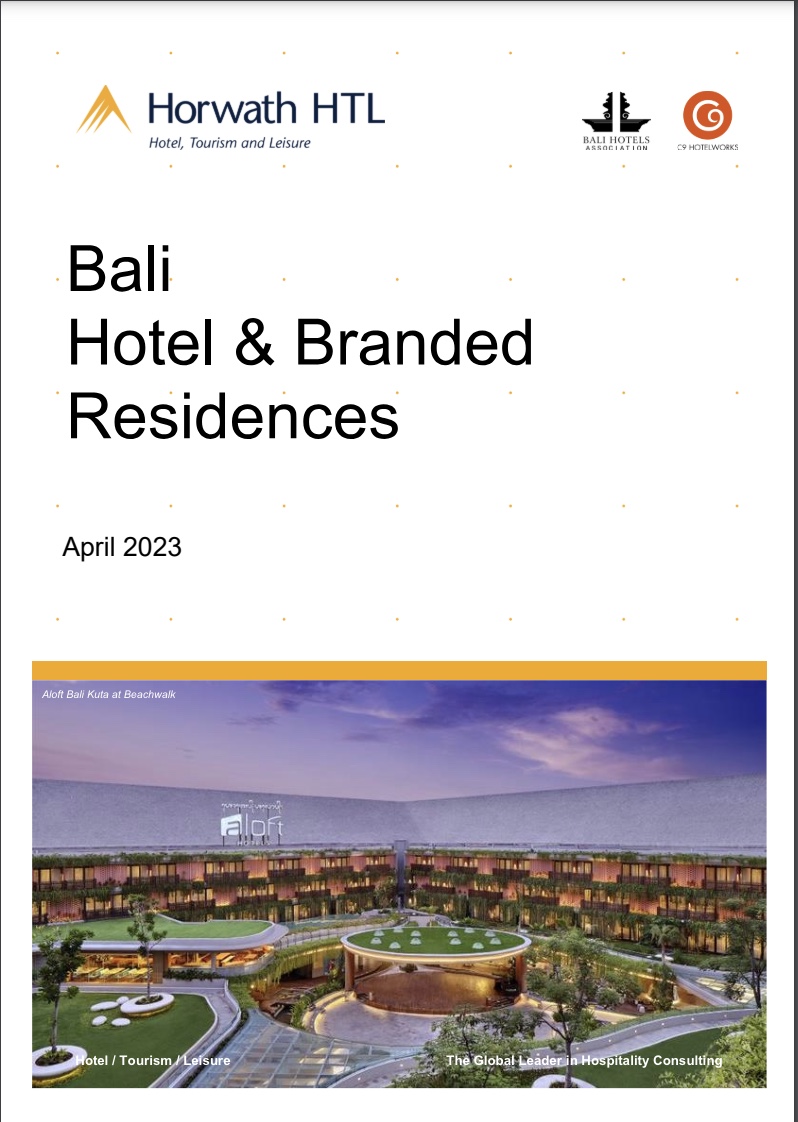
Report
Bali Hotels & Branded Residences 2023
The 2023 edition of the Bali Hotel & Branded Residences Report by Horwath HTL provides a comprehensive analysis of the market dynamics, performance metrics, and outlook for Bali’s hospitality sector. This summary highlights key findings from the report.
2022 marked a significant recovery for Bali's tourism industry as travel restrictions were eased and eventually removed. A quarantine-free trial period and Visa on Arrival (VOA) program initiated in March 2022, expanded to 86 countries by September 2022, fueled this recovery. Foreign arrivals surged, particularly from May onwards, with December 2022 numbers only 32% below pre-pandemic levels. Domestic tourism remained resilient throughout the pandemic, providing a crucial lifeline.
Visitor Arrivals
Bali recorded 2,155,747 foreign arrivals in 2022, a substantial increase from 2020 but still one-third of the pre-pandemic 2019 levels. Domestic tourism also showed strong numbers, with 8,052,874 visitors, only 24% less than in 2019. The Indonesian government aims to attract 4.5 million foreign tourists in 2023 through various cultural, sporting, and MICE (meetings, incentives, conferences, and exhibitions) events.
Nationality Mix
The nationality mix of visitors to Bali saw a notable shift due to travel restrictions, particularly from China, which enforced a zero-COVID policy. In 2022, Australia was the leading source of visitors (28%), followed by India (8%) and Singapore (6%). The representation of non-ASEAN Asian countries decreased significantly. With China’s borders reopening, a gradual return to the 2019 nationality mix is anticipated.
Overall Hotel Performance
In 2022, Bali’s hotels showed impressive recovery across all performance metrics. ADR (Average Daily Rate) surpassed 2019 levels, despite the devaluation of the Indonesian Rupiah. Occupancy rates reached over 50%, with Q4 2022 outperforming Q4 2019 in many metrics due to increased accessibility and significant events like the G20 summit.
Performance by Rate Segment
- Luxury Segment: Occupancy rose by 316%, ADR by 28%, and RevPAR by 433% compared to 2021.
- Upper Upscale Segment: Occupancy increased by 89%, ADR by 48%, and RevPAR by 178%.
- Upscale Segment: Occupancy increased by 245%, ADR by 114%, and RevPAR by 637%.
- Upper Midscale Segment: Occupancy increased by 177%, ADR by 84%, and RevPAR by 410%.
- Midscale Segment: Occupancy increased by 217%, ADR by 61%, and RevPAR by 412%.
- Economy Segment: Occupancy increased by 274%, ADR by 82%, and RevPAR by 579%.
Performance by Location
Kuta/Tuban and Seminyak recorded the highest occupancy rates for 2022, benefiting from their popularity among both domestic and international tourists. ADR improvements were significant across all areas, with Jimbaran and Uluwatu showing the most notable increases.
Average Length of Stay (ALOS)
ALOS increased in 2022 with the return of international tourists, although it remains below 2019 levels. Kuta/Tuban and Sanur saw increases in ALOS due to their popularity among digital nomads.
2023 Outlook
The first two months of 2023 show promising signs for Bali’s hotel industry, with occupancy rates at 62.8%, close to 2019 levels. ADR has increased significantly, leading to a record high RevPAR. Upper Upscale hotels and the Sanur area have shown remarkable performance improvements.
New Supply
New hotel developments are expected to add 2,379 rooms by the end of 2025. This includes significant projects in Ubud, Jimbaran, and Uluwatu. The new supply spans across various positioning segments, with a strong emphasis on luxury developments.
Branded Residences
Bali’s branded residences market, while lagging other Southeast Asian markets like Thailand and Vietnam, is seeing renewed interest post-pandemic. Key factors driving this include economic transmigration, urban flight, and the rise of the remote work culture. The outlook for branded residences is positive, with notable projects like the Raffles Bali villas set to launch.
Download the report
For detailed charts, graphs, and further analysis, download the full report here




